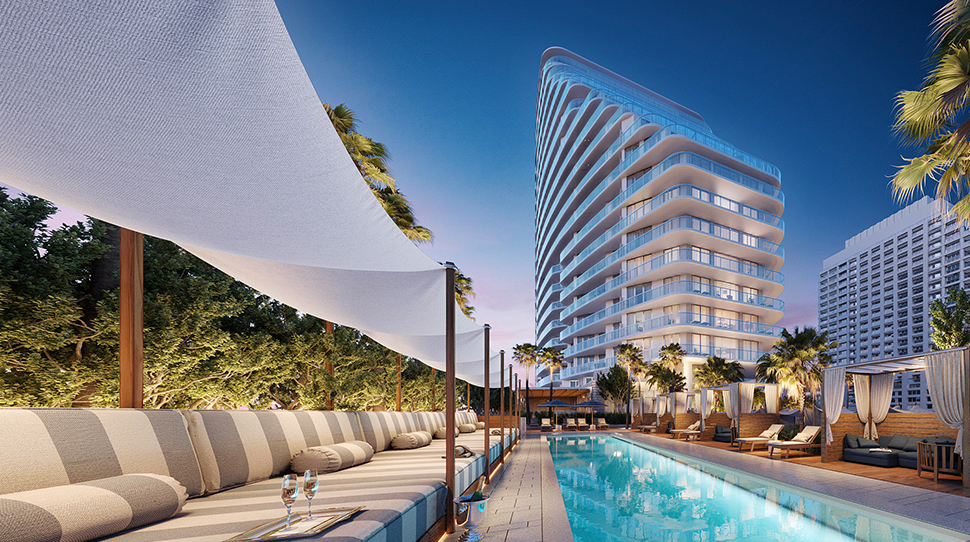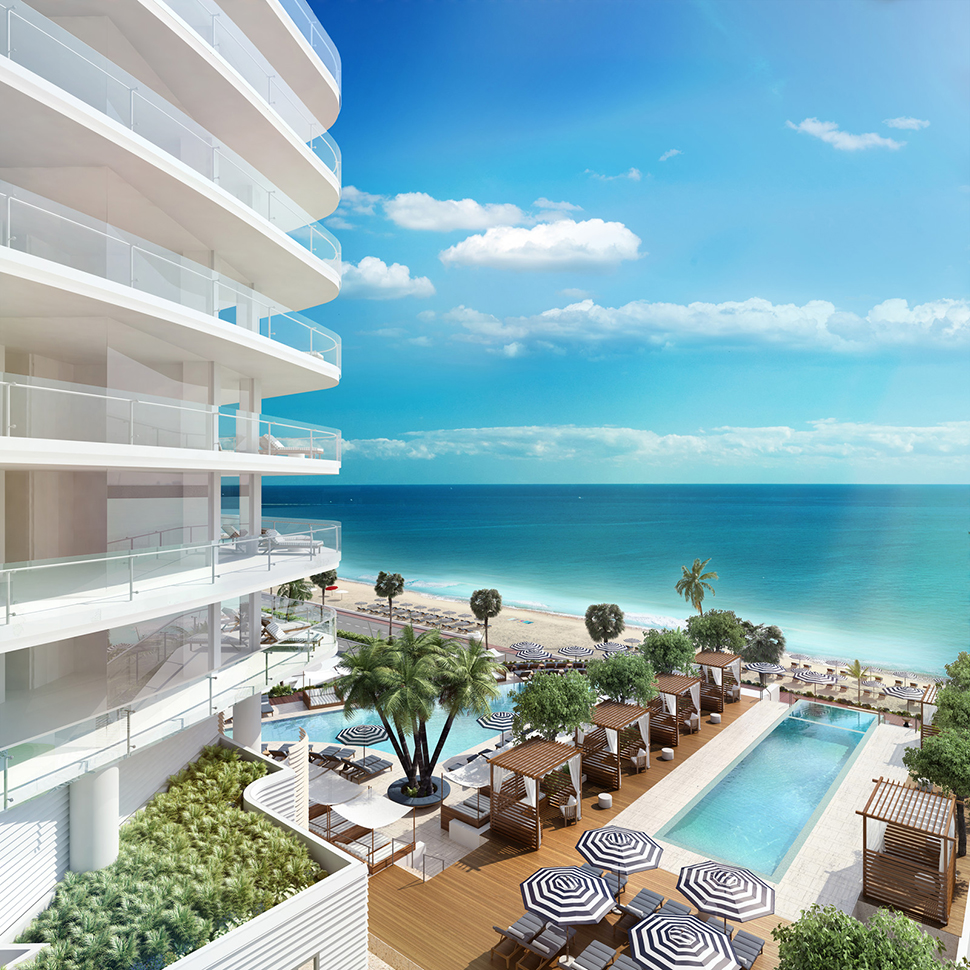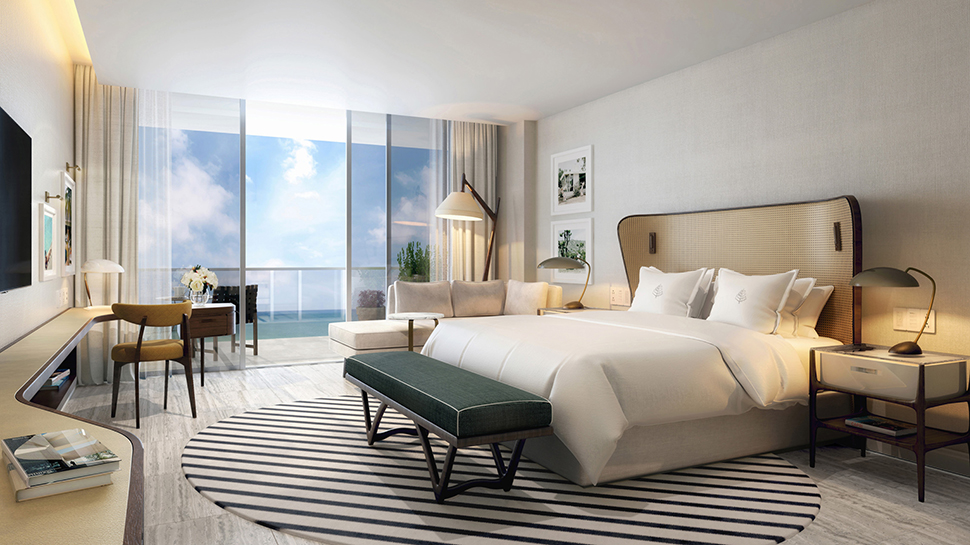

The new Four Seasons Hotel and Residences Fort Lauderdale anchored itself in the city’s coastline with a 22-story, yacht-shaped building from prominent Miami-based architect Kobi Karp.
But there’s depth to the distinctive design, which makes the enterprise both eye-catching and resilient. Karp, whose credits include the tropical-glam Four Seasons Hotel at The Surf Club and the eco-chic 1 Hotel South Beach, brings sustainability to the forefront (more on that later).
Four Seasons Fort Lauderdale will have 189 accommodations — including 19 suites and 41 hotel residences — with nautical touches and Atlantic Ocean or Intracoastal vistas, a six-treatment-room spa and two infinity pools. And a third of the property will be devoted to green space.
In anticipation of the hotel’s early 2022 opening, Karp took some time out from designing the Legacy Hotel & Residences at the Miami Worldcenter, the world’s first COVID-conscious skyscraper and medical center, to share what else we can expect at the sun-soaked Fort Lauderdale getaway.

Tell us about Four Seasons Hotel and Residences Fort Lauderdale.
It’s one-of-a-kind luxury. The development takes up a whole city block on the east side, which is the seaside of historic Fort Lauderdale. It’s a thoughtful project: it’s a sustainable and resilient design in a hurricane-impact district here in the tropics.
The building shape takes inspiration from the nearby yachts and marinas and the boat show, which is an annual event in the area. The shape is rather unique because it complies with the tropical sun and the shadow mitigation for the beach.
At the ground level, it is a linear park where the folks who stay at the hotel, live at the residences and even the community can walk around the whole block and have outdoor, tropical shaded gardens to enjoy some magnificent sunsets and sunrises. The building also has 360-degree views of Las Olas and the downtown skyline, which is quite magical.
The designers on the inside we selected are Tara Bernerd — she’s phenomenal, from London originally. The food and beverage [design] is from a gentleman who has finished the restaurant with me at the Four Seasons Surf Club, Martin Brudnizki. And these linear parks, pocket parks and outdoor dining terraces — which rise up and step down, so people can have three-dimensional views of the community and the streets — were done with Fernando Wong, the landscape architect. You have this assembly of designers who are thoughtful and creative and are looking to push the envelope for the Four Seasons brand, in what is their flagship in Broward County on the seafront, which has a very rich history.

Four Seasons has a very stunning two-level rooftop mansion in the sky, if you will, that has 360-degree indoor-outdoor spaces with panoramic views of the natural environment. You can open up the building and enjoy it now more so than ever before due to COVID. For example, when you come in the front, the door automatically opens up. You don’t need to touch anything. When you check in, it’s automatic. When you come to the elevator, it has the ability to open automatically —you don’t need to touch any buttons — and it lets you off at your floor. You get to your floor and walk to your apartment, condo or hotel suite, and we have touchless security there. You have a minimal amount of need to touch surfaces prior to entering this building.
Since you are working with some of the designers from the Surf Club, should we expect a similar vibe?
There was a certain DNA that came from creating a [well-known Miami architect] Russell Pancoast restoration and bringing you into those spaces. That is a “wow” experience. That building has been a private, exclusionary club since its creation in 1932 — which was almost 90 years ago.
Here, you have a brand-new building that is designed to be more sustainable and resilient. The finishes, the materials will be more contemporary and more nautical and will pay more respects to the Fort Lauderdale bayside and seaside community. It will not be in the same design as the Surf Club, but it certainly will be in the DNA of the new cutting-edge Four Seasons. The Four Seasons has really stepped up the designs and the direction, both at the Surf Club and at Fort Lauderdale.

What excites you most about this particular design?
The shape of the building is very unique and different on all sides. And there has not been a design or structure like that done in Fort Lauderdale or, for that matter, anywhere under the Four Seasons name. Even at the Surf Club, we designed the building as more rectilinear, more conservative glazed volumes. Here the shape is a bit more free-flowing, more feminine, more billowy, more nautical. It’s a step away from the way Four Seasons was previously represented.
What’s the special component that makes a hotel part of the community fabric?
The design and the guest experience are the most important things. It’s what makes people want to come back. And then there is the shared guest experience, meaning how the guest shares their experience with the community.
There’s a state-of-the-art fitness center, two pools with luxury cabanas, beach butler service, yachting services. Even the guest’s pets will have their very own pet concierge and on-call veterinarian.
Those are the kinds of things that we provide for the guest in our designs. And people see that when they come in the door. It’s like a grab-and-go not only of food but activities and experiences. It’s the secret sauce of the recipe that we tried to create.
Do you try to incorporate sustainability in your designs?
Yes. I think sustainable, resilient design is the flavor of the decade. My first degree was environmental design, so I’ve been practicing it 30-plus years. But what happens is that I always present sustainable, resilient design as not only good for the environment but as a good business decision. It saves you electricity, it saves you power.
We have really unique opportunities in the only subtropical/tropical weather climate in the lower 48 to do some cutting-edge designs, and that’s what I strive to do.
